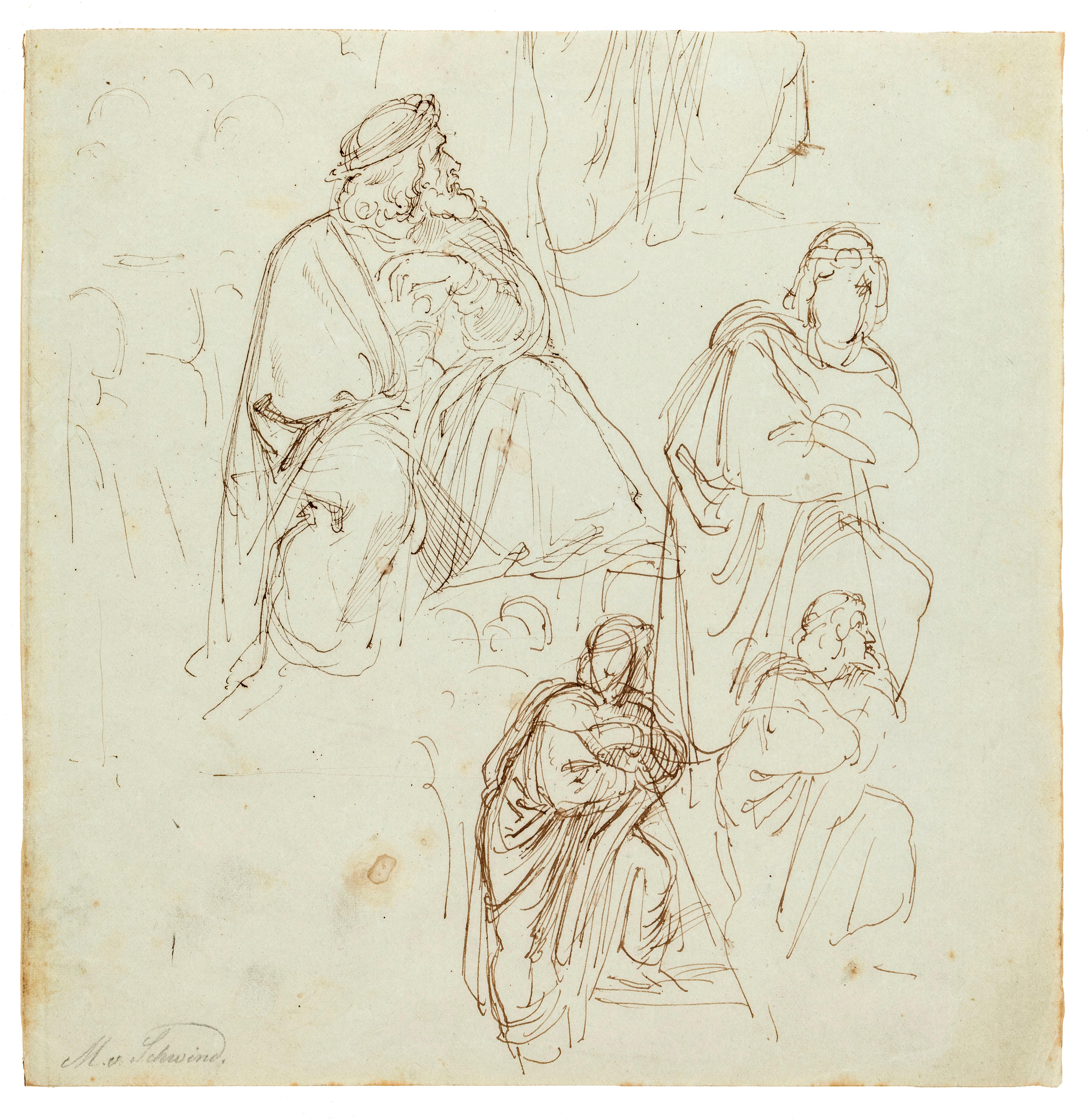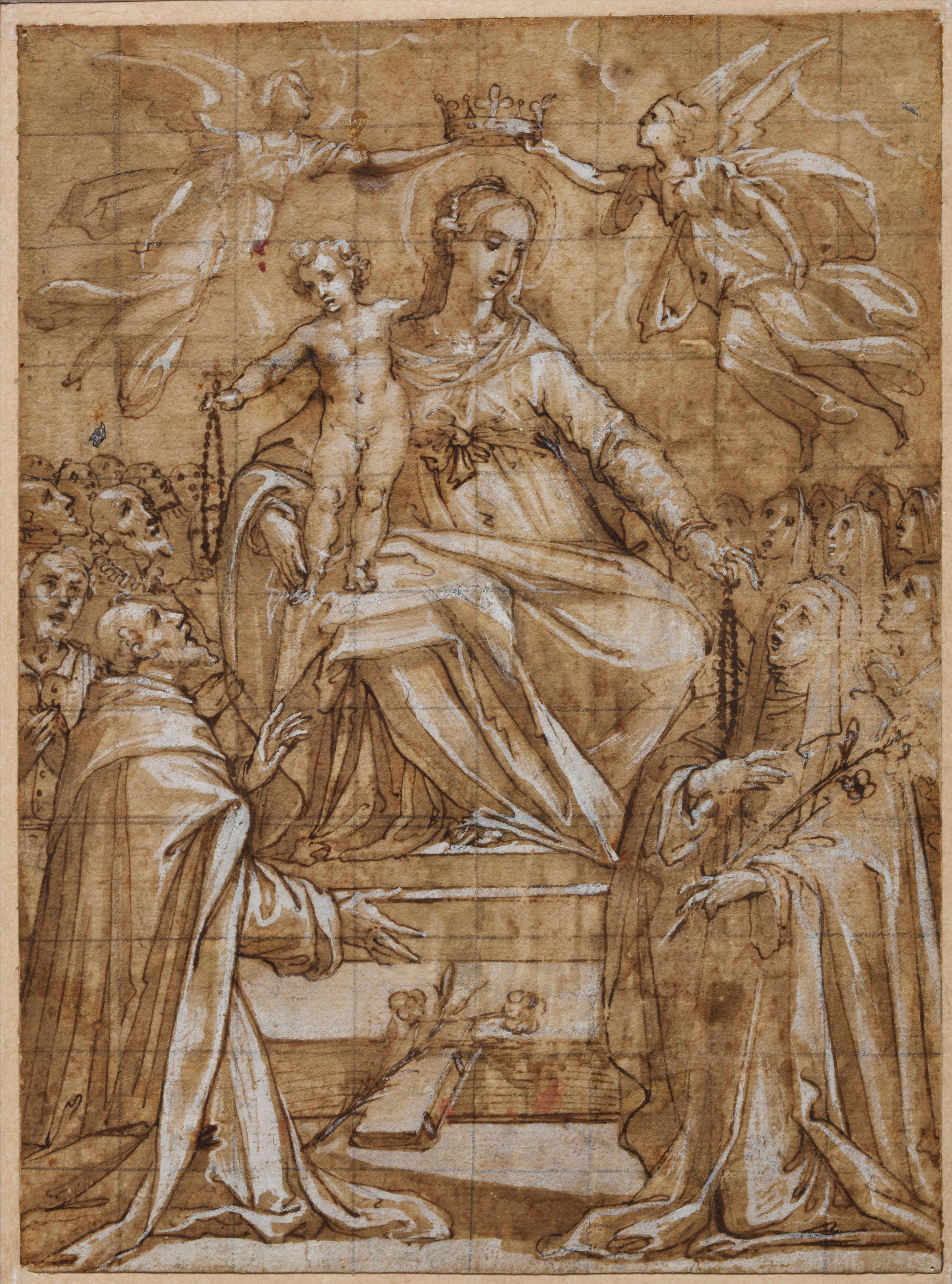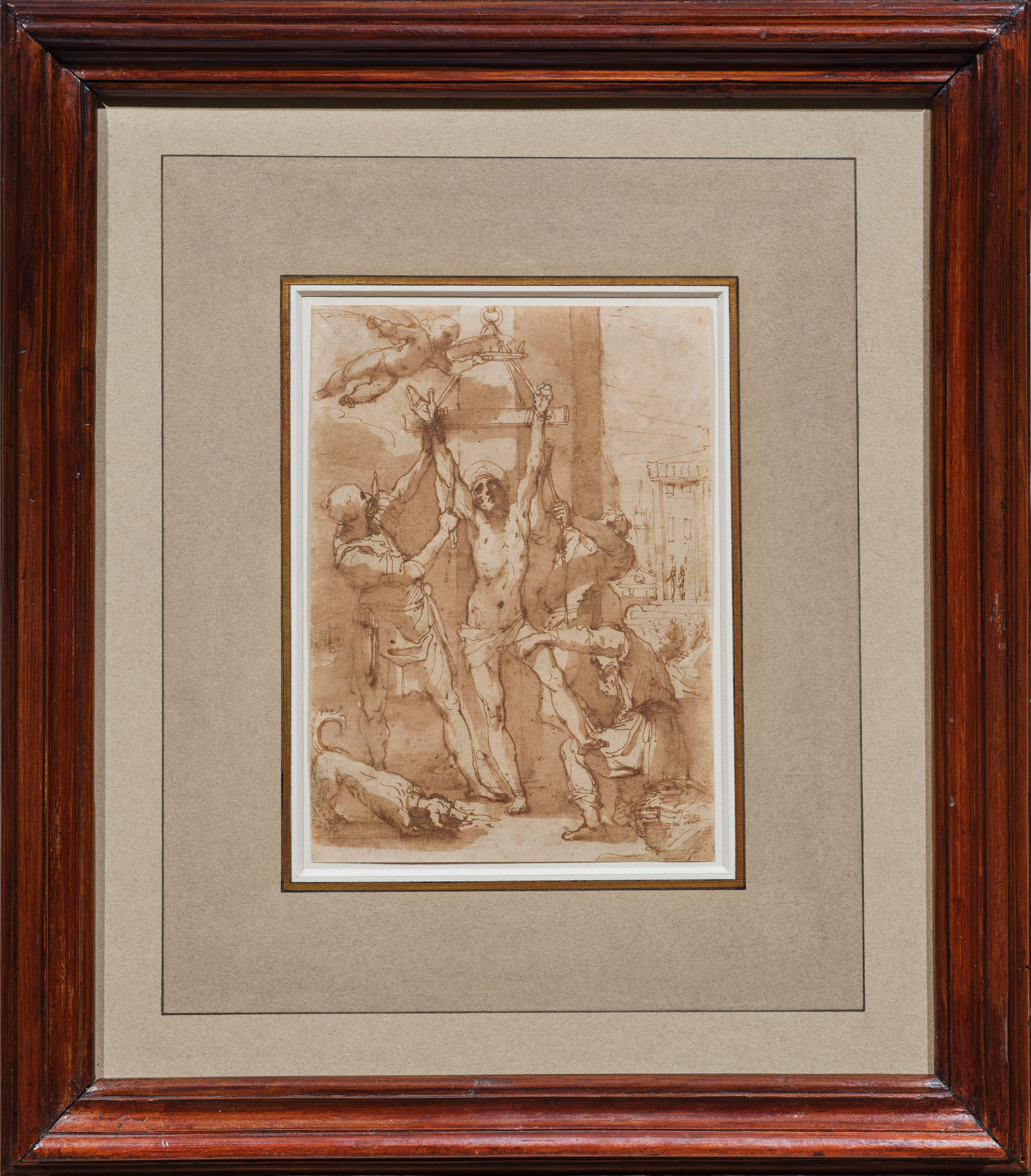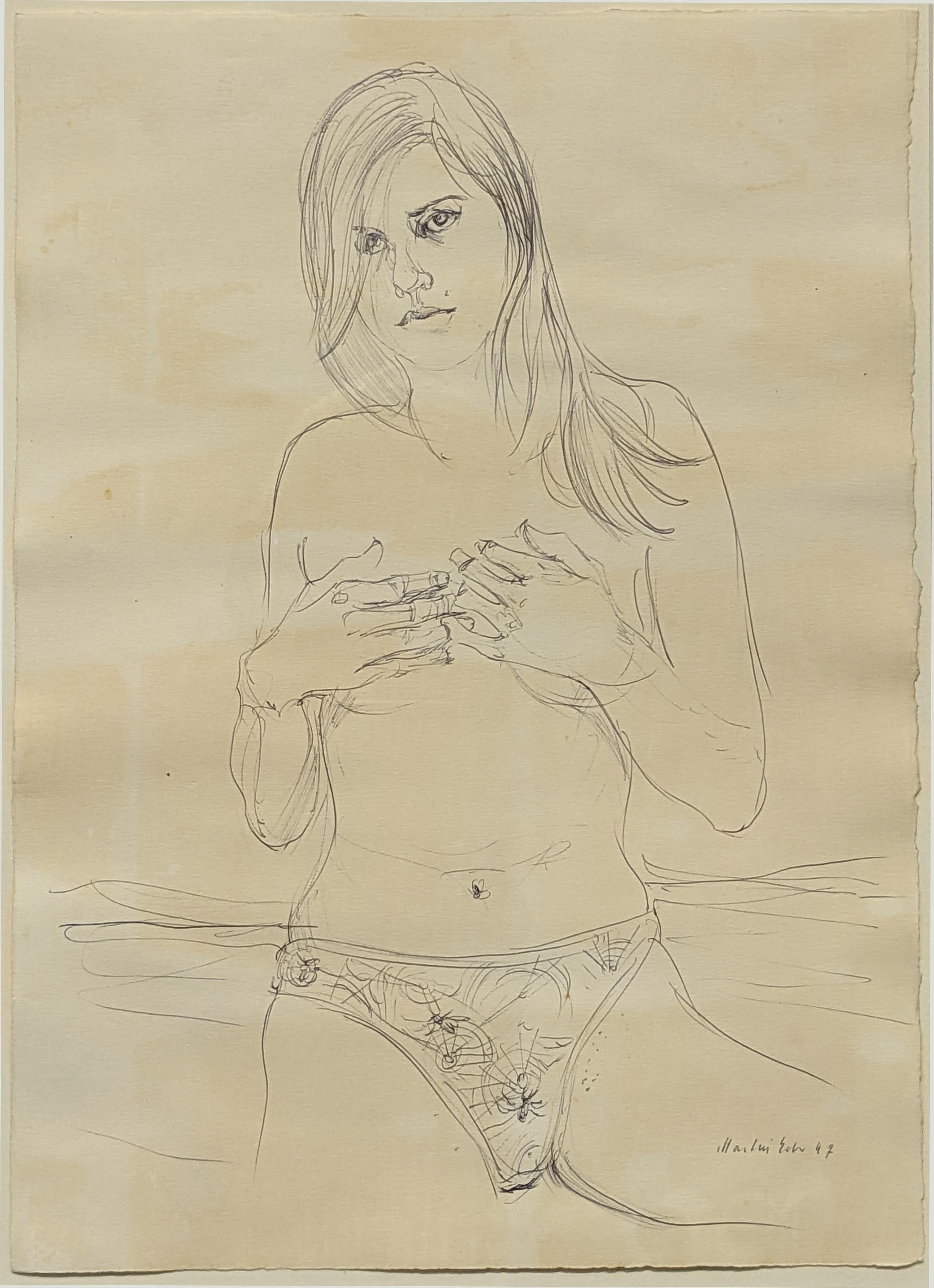Items Similar to Memorial - Drawing in Pen on Paper - 1950s
Want more images or videos?
Request additional images or videos from the seller
1 of 5
UnknownMemorial - Drawing in Pen on Paper - 1950s1950s
1950s
About the Item
Memorial is a drawing in pen on ivory paper realized in 1950 by Anonymous Artist of the 20th Century.
In very good condition, except for the yellowish part of the paper along the margins and small folding on the lower right margin due to the time which does not affect the image.
The artwork represents a memorial with its statue on the left and sketch of the landscape on the right depicted through confident and precise pen strokes.
- Creation Year:1950s
- Dimensions:Height: 16.54 in (42 cm)Width: 12.21 in (31 cm)Depth: 0.04 in (1 mm)
- Medium:
- Period:
- Framing:Framing Options Available
- Condition:Insurance may be requested by customers as additional service, contact us for more information.
- Gallery Location:Roma, IT
- Reference Number:
About the Seller
4.9
Platinum Seller
These expertly vetted sellers are 1stDibs' most experienced sellers and are rated highest by our customers.
1stDibs seller since 2017
6,749 sales on 1stDibs
Typical response time: 2 hours
- ShippingRetrieving quote...Ships From: Grasse, France
- Return PolicyA return for this item may be initiated within 14 days of delivery.
More From This SellerView All
- Nude from the Back - Original Marker Pen by Tibor Gertler - Mid 20th CenturyBy Tibor GertlerLocated in Roma, ITNude is an original Drawing in marker pen on creamy color paper realized by Tibor Gertler in the mid 20th century. Hand-signed on the lower right. Good conditions.v The artwork is...Category
Mid-20th Century Modern Figurative Drawings and Watercolors
MaterialsPen
- The Roman Column - Drawing in Pen - Mid 20th CenturyBy Mino MaccariLocated in Roma, ITThe Roman Column is an Original Drawing in pen on creamy-colored paper attributed to Mino Maccari in the mid-20th century. Good conditions with some foxing. Mino Maccari (1898-1989...Category
Mid-20th Century Modern Figurative Drawings and Watercolors
MaterialsPen
- The Sketches of Figures - Original Drawing by Norbert Meyre - Mid-20th CenturyLocated in Roma, ITThe Sketches of Figures is an original Drawing on paper realized by French painter Norbert Meyre in the mid-20 century. Drawing in pencil and pen and ink. Good conditions with a pi...Category
Mid-20th Century Modern Figurative Drawings and Watercolors
MaterialsPen, Ink, Pencil
- The Sketches and Portrait - Original Drawing by Norbert Meyre - Mid-20th CenturyLocated in Roma, ITThe Sketches and Portraits is an original Drawing on paper realized by French painter Norbert Meyre in the mid-20 century. Drawing in pencil and pen. Good conditions. The artwork ...Category
Mid-20th Century Modern Figurative Drawings and Watercolors
MaterialsPencil, Pen
- The Sketches of Figures - Original Drawing by Norbert Meyre - Mid-20th CenturyLocated in Roma, ITThe Sketches of Figures is an original Drawing on paper realized by French painter Norbert Meyre in the mid-20 century. Drawing in pencil and pen. Good conditions. The artwork is ...Category
Mid-20th Century Modern Figurative Drawings and Watercolors
MaterialsPen, Ink, Pencil
- Cats and Riders - Original Drawing by Norbert Meyre - Mid-20th CenturyLocated in Roma, ITCats and Riders is an original Drawing on paper realized by French painter Norbert Meyre in the mid-20 century. Drawing in pencil, pen, and ink. Good conditions. The artwork is re...Category
Mid-20th Century Modern Figurative Drawings and Watercolors
MaterialsPen, Pencil, Ink
You May Also Like
- Orpheus and the Animals, A Study after an Ancient Bas-ReliefLocated in New York, NYInscribed “55” and “218” in the lower right Watermark: Heawood 1351 Laid down on historic Cassiano Del Pozzo mount (Mount Type A, 531 x 402 mm) Provenance: Commissioned by Cassiano dal Pozzo (1588–1637) for his Museo Cartaceo (Paper Museum) and kept in the library of his palazzo, via dei Chiavari, Rome Transferred with the entire dal Pozzo collection by fidecommesso to his younger brother, Carlo Antonio dal Pozzo (1606–1689); by descent to his second son: Gabriele dal Pozzo (d. 1695); by descent to his wife: Anna Teresa Benzoni and after her remarriage in 1697, the Marchesa Lancellotti de’ Ginnetti (d. 1736); by descent to their son: Cosimo Antonio dal Pozzo (d. 1740); by whom sold with the Dal Pozzo library in 1703 to: Pope Clement XI for the Vatican Library; by whom transferred as part of the Museo Cartaceo in January 1714 to his nephew: Cardinal Alessandro Albani (1692–1779), Palazzo ‘alle Quattro Fontane’ in Rome; by whom sold in 1762 to: James Adam, agent for the British Royal Librarian Richard Dalton (1715–1791) King George III of England, Buckingham House Among the sheets of the ‘Museo Cartaceo’ appropriated by Richard Dalton during a reorganization of the drawings, circa 1786-1788; his estate sale, Greenwood’s, London, 11-19 May 1791; where acquired by: John MacGowan...Category
16th Century Baroque Figurative Drawings and Watercolors
MaterialsPaper, Ink, Pen
- Studies of a Seated Figure for “The Contest of the Minnesingers at the Wartburg”Located in New York, NYProvenance: Wilhelm Suida; thence by descent to: Robert L. and Bertina Suida Manning, New York, until 1996 Private Collection, USA. Moritz von Schwind had a long and varied career. He first trained at the Akademie der Bildende Künste in Vienna in the early 1820s, and by the 1840s held positions as professor of painting at the Städelsche Kunstinstitut in Frankfurt am Main and later at the Akademie der Bildenden Künste in Munich. Schwind was the painter and illustrator par excellence of medieval German...Category
1840s Drawings and Watercolor Paintings
MaterialsPaper, Ink, Pen
- Modello for the Virgin of the Rosary, a drawing by Francesco Vanni (1563 - 1610)Located in PARIS, FRFrancesco Vanni is one of the last representatives of the long Sienese pictorial tradition. In this masterly composition in pen and ink wash, he presents the Virgin of the Rosary, holding the Child Jesus on her lap, surrounded on her right by Saint Dominic and on her left by Saint Catherine of Siena. The presence of these two emblematic saints of the Dominican order is a reminder of the devotion of this order to the Rosary. 1. Francesco Vanni, a Sienese painter of the Counter-Reformation Francesco Vanni was the most important Sienese painter of the late sixteenth century and a key Italian Counter-Reformation painter. He developed a very specific style, inspired not by Florentine models but rather by the Roman, Bolognese and Marche schools, and in particular by the work of his contemporary Federico Barocci (Urbino 1535 - 1612), despite the two artists never meeting. Francesco Vanni was born in Siena around 1563-1564. His father died in 1567 and his mother remarried Arcangelo Salimbeni (1536 - 1579), then one of Siena’s leading painters. His half-brother Ventura Salembini (1568 - 1613) also became a well-known painter. He continued his apprenticeship in Bologna and Rome, where he joined the painter Giovanni de Vecchi’s (1536 - 1614) studio, where he was greatly influenced, like other Tuscan painters of the time, by the art of Federico Barocci. He devoted himself mainly to religious painting, following the canons of the Counter-Reformation. Travelling between Siena, Rome, Bologna and Parma, in 1604, he settled in Siena, where he ended his life. Vanni was also an important member of the Confraternity of the Sacro Chiodo, renowned for its demanding religious practices. His legacy also includes some important engraved work. 2. Description of the artwork The Virgin is depicted enthroned in majesty, slightly taller than the other figures that she dominates from her pedestal. Her wide robe with marked folds evokes Renaissance statuary. She is crowned by two angels in the sky. These two angels are a reminder of the custom of adding angels to crown 13th century icons which was frequent at Vanni’s time. The Child Jesus is standing on the Virgin’s right knee. With her left hand she holds out a rosary to Catherine of Siena, identifiable by a branch of lily in her hand. In a symmetrical gesture, the Child Jesus also holds out a rosary to St Dominic. Two of St Dominic’s attributes are to be found at the foot of the Virgin: a book and a branch of lilies. Vanni gives particularly delicate treatment to St. Dominic's long and slender hands. The two outstretched rosaries form the link between the heavenly register of the Virgin and the Child Jesus and the earthly register of the two Dominicans who are not crowned with a halo. This and the fact they are followed by a large crowd, indicates that they are both represented as part of the multitude of the living called to pray to the Rosary. According to the classical iconographic tradition, it would be plausible to consider that the figure looking at the viewer on the extreme left of the drawing could be a self-portrait of the painter. Francesco Vanni's face is known to us from a self-portrait kept in the Pinacoteca Nazionale in Siena. The squaring of the drawing suggests that it was used for a larger-scale altarpiece, probably for a church dedicated to St Dominic or for a Dominican convent. As of today, we have not identified the painting for which this drawing served as a preparatory modello. The Madonna of the Rosary in the Cathedral of Pitigliano (painted by Francesco Vanni in 1609) differs quite significantly from our drawing by the addition of Pope Pius V, and the inclusion of St. Dominic and St. Catherine in the celestial register. We believe that our drawing predates this painting because of its more symmetrical composition, and less Baroque influence. The presence of Saint Catherine of Siena, particularly venerated in his native town, to which Francesco Vanni returned frequently from 1590 onwards, leads us to propose a date of around 1590 - 1600 for this drawing. 3. The Rosary and the Dominican Order In order to clarify the iconographic meaning of this artwork, it is worth recalling the role of Saint Dominic in the spread of the Rosary prayer. Dominic Nuñez de Guzman was born around 1170 in Caleruega (near Burgos) in Spain and died in 1221 in Bologna, Italy. He was the founder of the order of friar preachers, commonly known as the Dominicans. He was canonised by the Church in 1234 and has since been celebrated under the name of Saint Dominic. After three days of prayer in the forest of Bouconne, near Toulouse, Dominic is said to have received the Rosary as a means of converting the Cathar population. The Dominicans subsequently made a special effort to promote this form of meditative prayer. Pope Pius V, a Dominican, included the feast of the Rosary (on October 7th) in the liturgical calendar in 1571. Rosary prayer has evolved over the centuries and traditionally consists of the recitation of three rosaries (four since St John Paul II). Each rosary consists of five tens of "Hail Mary...Category
16th Century Old Masters Figurative Drawings and Watercolors
MaterialsPen, Ink
- The Martyrdom of Saint Bartholomew, a preparatory drawing by Alessandro CasolaniLocated in PARIS, FRThis powerful pen and brown ink wash drawing is a study for an altarpiece depicting The Martyrdom of Saint Bartholomew. Signed and dated 1604, it was painted at the end of his life b...Category
Early 1600s Old Masters Figurative Drawings and Watercolors
MaterialsInk, Pen
- untitled / ohne TitelBy Martin EderLocated in New York, NYMartin Eder untitled work on paper executed in ballpoint pen with traces of watercolor. Ohne Titel Arbeit auf Papier, ausgeführt in Kugelschreiber mit Spuren von Aquarell. 2007Category
Early 2000s Realist Nude Drawings and Watercolors
MaterialsInk, Watercolor, Pen
- No titleLocated in Tel Aviv - Jaffa, ILOriginal mixed media on paper Handsigned Unique piece PINKHAS (Born in 1975) SOLOS EXHIBITIONS 2022 Gallery 55 TLV Tel Aviv Israël 2021 Gallery 55 TL...Category
21st Century and Contemporary French School Figurative Drawings and Wate...
MaterialsInk, Acrylic, Felt Pen





